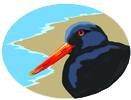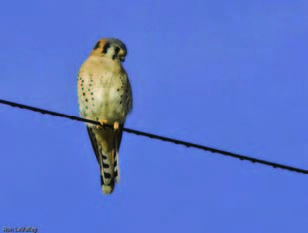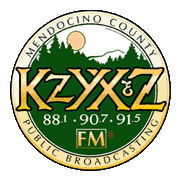At nine inches the American Kestrel is our smallest falcon. It has been also called sparrow hawk. This common year-round resident can be seen hovering over fields or perched on telephone poles along roadways, peering down intently for food. The American Kestrel's diet consists mainly of insects such as grasshoppers, dragonflies and beetles. They also eat mice, small birds, lizards and frogs.
The American Kestrel is a beautiful bird with two distinct black facial stripes. The male has a rufous or rusty back, blue-gray wings and crown, and a rufous cap. Its long red tail has a broad black band across it. The female has a rusty back and wings and the rusty tail is barred.
The kestrel is a solitary bird even in breeding season. Division of labor is so extensive that each of a mated pair spends most of its time alone. Once a pair has picked a nesting site, a hole in a tree or an old woodpecker cavity, the female stays close to the nest and the male brings food to her. This can last for as long as twelve weeks. The male defends a hunting territory, as large as 250 acres. Smaller territories are sometimes defended all year.
The female incubates 4-6 darkly-spotted, cream-colored eggs for up a month. The male provides breaks for her daily. They spend another month and a half caring for the young until the fledglings leave the nest. Needless to say, they usually raise only one brood per season.
American Kestrel male photo Ron LeValley www.LeValleyphoto.com


